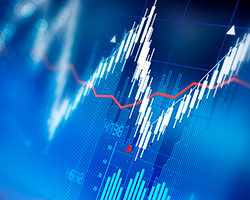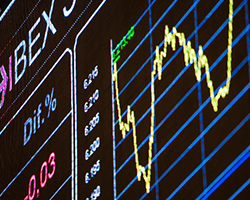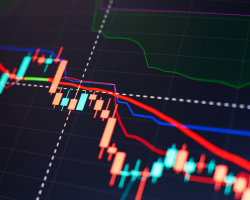The Volatility of Currency Pairs - Everything You Need to Know in 2022
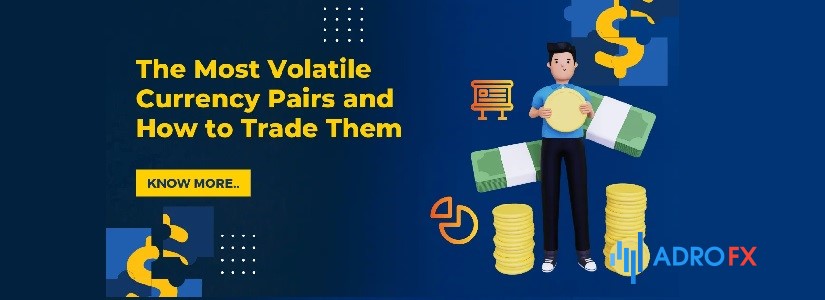
Most traders and investors are often confronted with such a purely market concept as "volatility". This term is used to analyze price movements as well as to characterize the trading instruments themselves in any financial market.
Below you will learn what is the volatility of currency pairs - the concept, definition, characteristics, and how to use it when making trading decisions.
What is the volatility of currency pairs?
Volatility is a statistical financial index that describes the amplitude of price movements of a single trading instrument.
Obviously, the concept of the volatility of currency pairs applies to the quotes of assets at forex. The volatility of currency pairs is an indicator of the ability of price deviation from the current rate.
In simple words, the volatility of currency pairs is understood as the number of points which the price of the currency pair for a certain period of time. It should be noted that the stock market's volatility is measured as a percentage, the forex market is usually calculated in points. To convert percentages into pips, simply multiply the percentage figure by 100.
For example, the currency pair GBP/JPY (British pound/Japanese yen) is called the "Dragon" for its fairly high volatility. It may go 150-250 pips upward or downward during the trading session. EUR/CHF pair (the Euro to Swiss Franc ratio) is considered as low volatility, usually making only 35 to 40 pips within a trading session.
It should be noted that the term "volatility" in the field of trading and finance has another important meaning. It characterizes not only the price variability of a single trading instrument but also significant price changes on the market as a whole. So traders often use the terms high volatility markets or trading sessions with low volatility or periods of increased volatility.
What does the volatility of currency pairs depend on?
Most stock market analysts believe that the price volatility of trading instruments depends primarily on their liquidity.
Liquidity is the ability to be sold quickly at market value. In simple words, liquidity is the marketability of an asset.
For example, the South African rand will sell more slowly than the dollar, which many more people need. The liquidity of the dollar will be higher.
A low-liquid (difficult to sell at close to market price) asset tends to have high volatility. To sell such a security, the owner has to look for a buyer, making a significant discount. This causes a strong downward price movement. When buying such an instrument, it is possible to find a deficit on the market. Consequently, the buyer will have to buy a part of the estimated transaction volume at a price much higher than it was originally stated. It will be reflected by the market as a strong upward price movement.
Highly liquid (easily sold at a price close to the market) assets, on the contrary, have low volatility. It is often said about such trading instruments that "there is always a buyer and a seller, no matter what the price is". Their price movements are rather even and have low amplitude because the proprietor can easily sell, and the buyer can buy them on the market.
Obviously, liquidity is one of the fundamental factors in the volatility of any trading instrument. However, various types of assets are also regularly influenced by strictly specific circumstances that can significantly strengthen or weaken price movements.
It is believed that in addition to liquidity, the volatility of currency pairs can be significantly affected by:
- Global factors (armed international conflicts, crises, disasters, achievements), pandemics, epizootics);
- Local events (instability in a certain region of the world, political crisis, change of interest rates in the country, growth/decline of GDP and other economic indicators, epidemics, epizootics);
- Industry factors (successes or crises in a single industry, so the growth of wind energy, has led to lower returns in the oil and gas industries - the currencies of hydrocarbon exporting countries have fallen in price);
The structure of the currency pair (so if the pair consists of currencies of the countries whose economies are fundamentally different, for example, one state produces hydrocarbons, and the economy of the other one is exclusively the service sector, the pair will be highly volatile, the states of each currency have a significant difference in interest rates);
Currency crosses (pairs without the American dollar and pairs without a major, exotic currency in the structure will have high volatility and larger spreads between supply and demand).
Presence/absence of regulators (the presence of both national and international regulatory organizations makes regulated currencies more stable).
From these factors, the volatility of each single currency pair on the market is formed. However, in practice there are more components, which can both increase or decrease the amplitude of price movement of any instrument - it is the volatility of the market in which the instrument is quoted and the volatility of trading session (trading time).
Forex trading is carried out round the clock. However, every 24 hours are divided into trading sessions, the volatility of which has significant differences:
- Asian (generally has low volatility, except traditionally Asian currency pairs);
- European (has high volatility);
- American (the most highly volatile session, very often maximum volatility values are registered there for a wide range of trading instruments);
- Pacific (has the lowest volatility).
Obviously, currency pairs with high volatility will show the maximum possible amplitude of price movement exactly during the American trading session. At the same time, the Pacific time interval will have a restraining effect on these instruments.
How to measure the volatility of currency pairs
Information about the amplitude of price movements of a particular currency pair and the market as a whole can be effectively used by traders and investors.
Most financial institutions measure volatility in pips or, less frequently, in percentages. Sometimes, data about the amplitude of the price movement can be presented in currency terms.
Calculation of the difference between the opening and closing price of the trading period is a rather primitive and time-consuming method. It is necessary to measure the length of each candle during the specified period, add up the data, and divide by 10. If the calculations are performed for a monthly or annual period, such work will turn into a rather laborious task.
A fairly simple way to determine the volatility of a currency pair on the market is to use a volatility calculator.
A volatility calculator is a software algorithm that allows you to calculate the amplitude of price movements of the selected currency pair over a specified period. The online volatility calculator can be found at myfxbook.
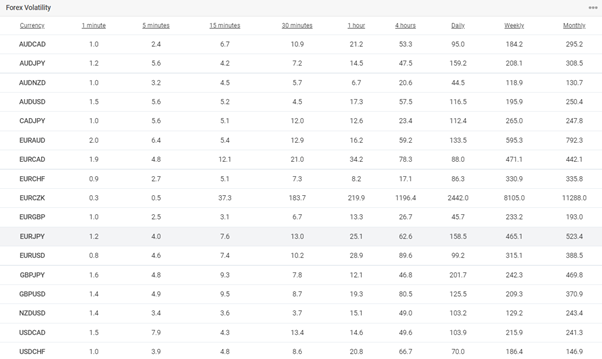
This calculator is presented as a table of 20 currency pairs, the volatility of which is already calculated for 9 periods, starting from 1 minute and ending with 1 month. The measurements are presented in pips and percentages. By clicking the three dots button in the upper right corner, you can add or remove trading instruments from the table. In total, 109 quotes are available for volatility estimation. Also, the calculator has a filter that allows you to find pairs that have volatility below/above a specified level.
How volatility affects trading currency pairs
Let's assume that a trader is trading intraday on GBP/USD. Since the market opening, the pair has moved 380 pips up. We know that the average daily volatility of this currency pair is 400 pips. The probability of further upward movement of GBP/USD is close to zero. Consequently, the trader should refrain from opening a long position and start considering the possibility of entering into a short position.
Similarly, trading decisions can be made on higher time frames.
As we can see, with the help of volatility estimation it is possible to suggest with a high degree of probability the future price movement and levels, at which it is possible to set maximum efficiency of losses limitation and profit fixation.
When setting a "floating stop order" - Trailing Stop, the amplitude of the price movement takes on special importance. Thus, on highly volatile trading instruments, the Trailing Stop step should be large, otherwise, the trader risks causing false closing of the order and gaining losses instead of fixing profits.
Volatility can also be the basis for certain trading strategies and psychological models of traders' behavior.
Thus, at forex, an investor wishing to receive constant income without high risk is recommended to invest in currency pairs with low volatility.
On the other hand, if an investor prefers aggressive trading, it is recommended to choose the instruments with high volatility. It may considerably increase the profitability.
High volatility currency pairs allow fixing more considerable differences between the transaction opening price and the asset cost when exiting the market. This allows you to capitalize on a more substantial price difference.
Investors who include volatility indicators into their trading system prefer to have information about the most volatile currency pairs, to know the periods of the lowest and the highest amplitude of price movements in the market in general and for each trading instrument in particular. It allows creating more optimized and effective trading strategies.
How the volatility changes during the trading sessions
We mentioned earlier that the volatility of a certain currency pair or even a whole group of trading instruments may depend not only on internal "classic" factors but also on some external circumstances.
One of the most important external conditions is a period (time) of a trading session. Two out of 4 trading sessions (American and European trade sessions) are highly volatile. However, this does not mean that the amplitude of the price movement of any instrument traded at that time will be higher than during the other two time periods. Each trading session has its currency pairs - "leaders" and "outsiders" of volatility.
In the Asian trading session, the greatest amplitude of the price movement is gained by the quotes having in their structure the Australian dollar (AUD) and Japanese yen (JPY).
Traditionally, the record amplitude of price fluctuations shows the currency pair GBP/JPY, fluctuations often cross the 300 pips mark, when the average volatility of currency pairs is in the range of 100-110, with the time period considered low-volatile.
The European trading session itself has fairly strong volatility. The currency pair GBP/CHF (British pound/Swiss franc) is averaging 150 pips per session, and when strong news is released, its price amplitude can easily pass the mark of 400-500 pips. Also, quite strong volatility has pairs GBP/USD, GBP/EUR, EUR/USD.
The American trading session is the most highly volatile. The most famous "ups and downs" in the financial world take place on the American trading floors; the most global crises start exactly in the USA and volatility grows tremendously.
The most volatile currency pairs of this session: are EUR/USD, GBP/USD, USD/CHF, AUD/USD, USD/CAD, USD/JPY. The "leader" of volatility, as well as during the European trading period, is GBP/GHF with an average daily index of 130 pips. This is a little lower than during the European trades, however, the situation changes drastically when the market activity increases. The peak amplitude of the price fluctuations of the GBP/CHF could easily exceed 800-1000 pips during the American session.
Pacific trading session. Some tutorials do not include information on this trading period, because the trading volumes at this time are not comparable with other sessions. This is the most low-volatility trading period, during which most currency pairs pass by 20-30 points during the day. The most volatile currency pair, as in the case with the Asian trading period, is GBP/JPY; on average it passes 50-70 points during the trading period.
The European trading session has 2 hours in common with the Asian one and 4 hours with the American one.
The Pacific period overlaps with the American period by 1 hour and with the Asian period by 9 hours, actually having just 1 hour of "personal" time.
And finally, the Asian trading session doesn't have its own separate time and is traded together with the Pacific and the European trading sessions.
This information should be considered especially by traders who look for/avoid periods of high volatility, because during such periods of "double activity", despite increased liquidity, the news background that can move the markets considerably increases as well.
The most volatile currency pairs
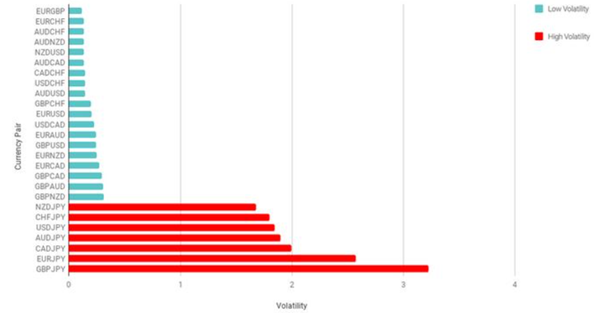
Pros and cons of currency pairs with high volatility
Considering the great number and cardinal differences between all trading systems, it is quite difficult to talk about certain advantages and disadvantages of high volatility. Yet, let us consider the most obvious ones.
Disadvantages of high volatility include:
- High trading risks;
- Significant spread when placing orders;
- Minimal time for decision-making;
- Low liquidity, as a consequence of delays and slippage in the execution of trading orders;
- Problems in the identification of trading signals;
- Inoperability of the majority of technical market analysis tools;
- High emotional tension when trading;
- The necessity of constant control of an open position.
Undeniable advantages of volatile currency pairs are:
- High trading profitability;
- Small-time payback period.
What is the best volatility of currency pairs for a trader?
The question of determining the best trading volatility is quite controversial. Traders who use hedging strategies prefer calm, low volatility markets and trading instruments. Many of them trade at night or during Pacific or Asian trading sessions. Night scalpers also work in the same way. At the same time, most scalping trading systems are intended for the highly volatile trading instruments, the trading is fast, highly risky with the strict observance of the strategy rules and it often brings the expected positive result.
However, let us imagine that a scalper trader has found a phenomenally volatile exotic trading pair. Having used the technical analysis tools required according to the trading strategy, the trader placed an order to open a position. An hour or two passes but the order is still not opened - there is no liquidity in the market, no traders are willing to buy/sell the pair but the trader himself at the price he requires. A day has passed and the order has worked, but the trader has been unpleasantly surprised by a huge spread that he still has to win back. After another three hours, the scalper understands that the position is not profitable and the market analysis is wrong.
In low liquid markets, most technical analysis tools are useless.
From the above example, we can conclude that volatility is quite an important characteristic of currency pairs, but when choosing a trading instrument it should be considered only after taking into account other no less important factors.
The most volatile currency pairs also cannot be the best choice. Their low amplitude of price movements will not allow the trader to reach the required level of profitability.
When trading without leverage, traders, first of all, should concentrate on currency pairs with a pronounced trend direction and high liquidity, and from the list of trading, instruments choose the most volatile ones. If trading is carried out with leverage, then it is advisable to give preference to a currency pair that has a clear trend direction and high liquidity, but at the same time has medium or low volatility.
Volatility Indicators
The use of indicators to determine the volatility can greatly facilitate the work.
Thus, Simple Moving Average (SMA) makes it possible to measure the average amplitude of the market movement for an arbitrary period.
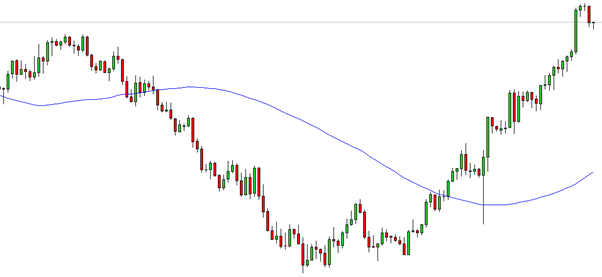
Thus, by setting on the chart 20 SMA, you can see the average movement of quotes over the past 20 days. Other varieties of Moving Averages may also be used to measure volatility.
In addition to the SMA indicator, the volatility of currency pairs is convenient to measure with the help of Bollinger Bands. When placed on the chart, Bollinger Bands represent two lines with two specified deviations.
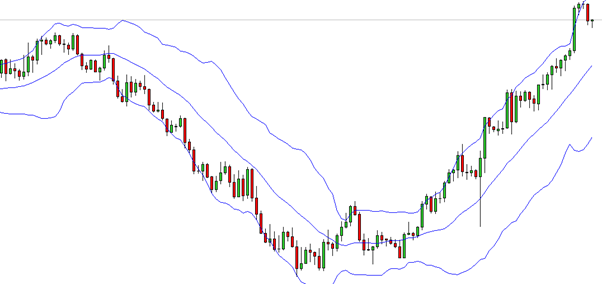
The bands' convergence to each other indicates low volatility in the market, the divergence of the opposite of the presence of high amplitude of price movement. The indicator also can specify an arbitrary time period for calculating the volatility.
Commodity Channel Index (CCI) can also be considered as an indicator of the volatility of currency pairs. The tool measures the deviation of the asset value from its average market value and is based on the price maximums of market opening/closing. The indicator's zero value corresponds to the average price of the trading instrument for the selected time period.
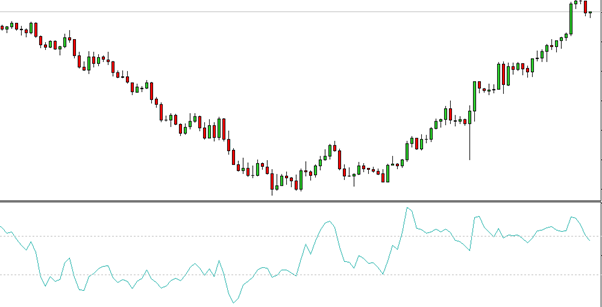
The intersection of levels 100 and -100 indicates a strong price movement relative to the averaged value of an asset and, consequently, the presence of high volatility.
A rather original way to determine the volatility in the market, using the Average True Range (ATR) oscillator.
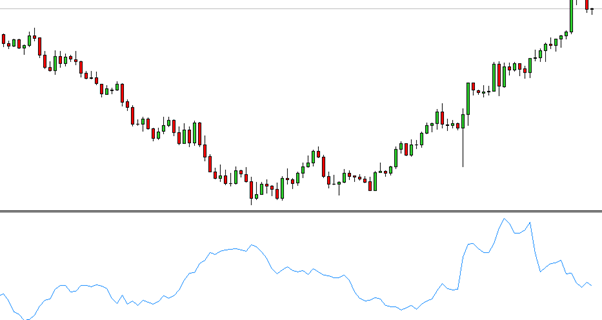
Small values of this means of technical analysis are interpreted as a sign of sideways price movement, high values - as a signal of the trend change.
However, in Curtis Faith's book "The Turtle Way. From Amateurs to Legendary Traders", it is suggested to use the indicator to determine the optimal loss limiting levels, i.e. setting Stop-Losses. Thus, at the ATR value of 350 points, it is recommended to set the stop order at 700 points from the deal entry price. Accordingly, the greater the distance from the entry point, the more volatile the instrument and the market as a whole, and vice versa. Similarly, you can also set Take-Profit levels, also determining the amplitude of price movements.
Conclusion
To sum it up, volatility is one of the most important characteristics of a currency pair as a trading instrument. Volatility can also characterize certain trading periods and markets in general.
However, despite the importance of the volatility indicator when deciding on choosing the most appropriate trading instrument, a trader should be guided by the trading system requirements and currency pair liquidity first of all. Once the trader has received the initial selection of trading instruments, he can begin choosing a currency pair based on its volatility parameters. Here it is necessary to take into account the size of your deposit and the use of leverage
About AdroFx
Being a well-established brokerage company, AdroFx offers the best trading conditions to its clients from 200 countries. Founded by experts with a couple of decades of overall experience, AdroFx is one of the best platforms on the market for shares trading. Either a newbie or experienced trader, both will find here what they are looking for since the company provides various trading accounts for different trading styles and goals.

